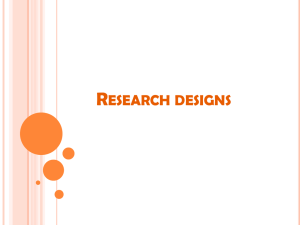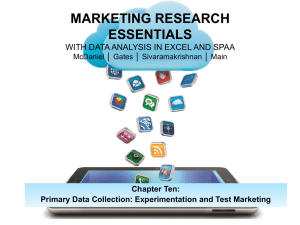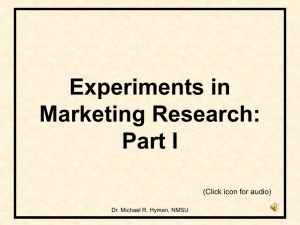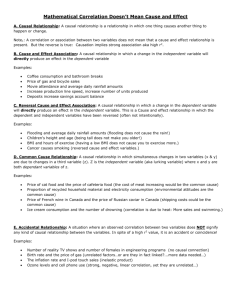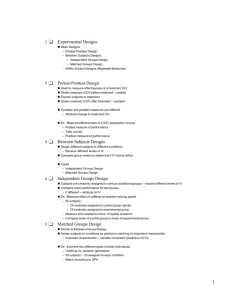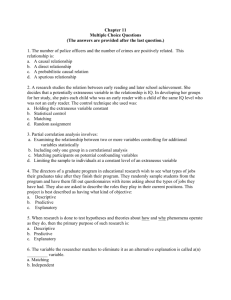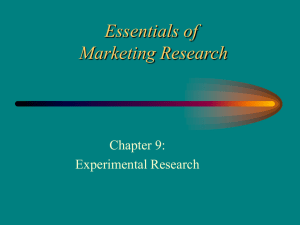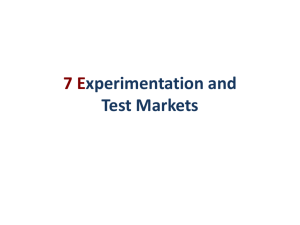因果研究设计
advertisement
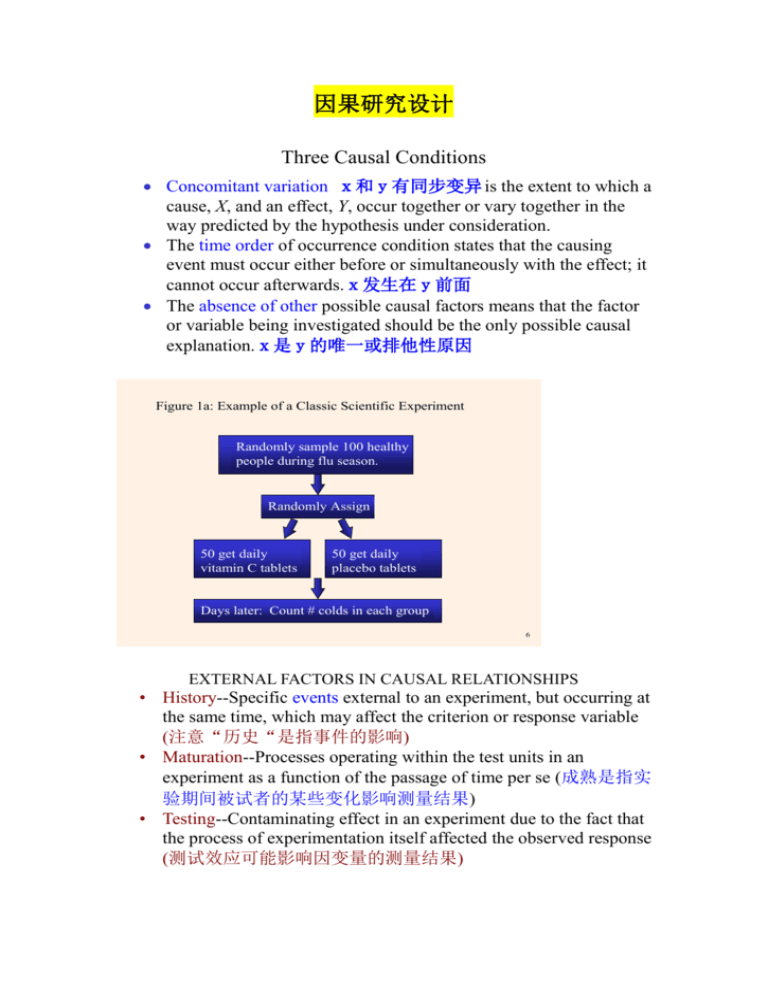
因果研究设计 Three Causal Conditions Concomitant variation x和y有同步变异 is the extent to which a cause, X, and an effect, Y, occur together or vary together in the way predicted by the hypothesis under consideration. The time order of occurrence condition states that the causing event must occur either before or simultaneously with the effect; it cannot occur afterwards.x发生在y前面 The absence of other possible causal factors means that the factor or variable being investigated should be the only possible causal explanation.x是y的唯一或排他性原因 Figure 1a: Example of a Classic Scientific Experiment Randomly sample 100 healthy people during flu season. Randomly Assign 50 get daily vitamin C tablets 50 get daily placebo tablets Days later: Count # colds in each group 6 EXTERNAL FACTORS IN CAUSAL RELATIONSHIPS • History--Specific events external to an experiment, but occurring at the same time, which may affect the criterion or response variable (注意“历史“是指事件的影响) • Maturation--Processes operating within the test units in an experiment as a function of the passage of time per se (成熟是指实 验期间被试者的某些变化影响测量结果) • Testing--Contaminating effect in an experiment due to the fact that the process of experimentation itself affected the observed response (测试效应可能影响因变量的测量结果) 2 • Main testing effect--the impact of prior observation /treatment on later observation (测试主效应指之前的测量影响后面的结果) • Interactive testing effect--the condition when a prior measurement affects the test unit’s response to the experimental variable (测试互 作效应指之前的测量和实验处理发生互作) • Instrument Variation--Any and all changes in the measuring device used in an experiment that might account for differences in two or more measurements (工具变异指测量工具改变引起变化) • Statistical Regression--Tendency of extreme cases of a phenomenon to move toward a more central position during the course of an experiment (统计回归指原来的极端值自动向平均 数靠拢的现象,和实验处理无关) • Selection Bias--Contaminating influence in an experiment occurring when there is no way of certifying that groups of test units were equivalent at some prior time (选择偏差指事先存在的 组间差异,和处理无关) • Experimental Mortality--Experimental condition in which test units are lost during the course of an experiment (实验者流失) 内源和外源效度 内源效度: 效果确实是由原因引起的吗? (例如:我们能够肯定对手机 的选择完全受广告影响吗?) 外源效度: 我们可以把结果推广到群体中去吗? (例如我们能把实验 室结果推广到市场上去吗?) Major Causal Designs One-Shot Case Study 一次性案例研究 X 01 • There is no random assignment of test units.无随机配置 • Appropriate for exploratory, not for conclusive research One-Group Pretest-Posttest Design 单组前试加后试设计 01 X 02 • A group of test units is measured twice. • There is no control group. • The treatment effect is computed as 02 – 01. • The validity is questionable since extraneous variables are largely uncontrolled. Static Group Design 静态组间对比设计 3 EG: X 01 CG: 02 • A two-group experimental design. • The experimental group 实验处理组(EG) is exposed to the treatment, and the control group 对照组(CG) is not. • Measurements on both groups are made only after the treatment. • Test units are not assigned at random. • The treatment effect would be measured as 01 - 02. True Experimental Designs 真实或完全实验设计 EG: R 01 X 02 CG: R 03 04 • Test units are randomly assigned to either the experimental or the control group. • A pretreatment measure is taken on each group. • The treatment effect (TE) is measured as: (02 - 01) - (04 - 03). • Selection bias is eliminated by randomization. • The other extraneous effects 外源效应 are controlled as follows: 02 – 01= TE 处理效应+ H 历史 + MA 成熟 + MT 测试主效 + IT 测试互作 + I 测量工具变异 + SR 统计回归 + MO 主体流失 04 – 03= H 历史+ MA 成熟+ MT 测试主效+ I 测量工具变异+ SR 统计回归+ MO 主体流失=EV(Extraneous Variables) • The experimental result is obtained by: (02 - 01) - (04 - 03) = TE + IT • Interactive testing effect is not controlled Posttest-Only Control Group Design 后试组间对照设计 EG : R X 01 CG : R 02 • The treatment effect is obtained by TE = 01 - 02 • Except for pre-measurement, the implementation of this design is very similar to that of the pretest-posttest control group design Time Series Design 时间序列设计 01 02 03 04 05 X 06 07 08 09 010 • There is no randomization of test units to treatments. • The timing of treatment presentation, as well as which test units are exposed to the treatment, may not be within the researcher's control. EG: 01 02 03 04 05 X 06 07 08 09 010 CG: 01 02 03 04 05 06 07 08 09 010 4 • If the control group is carefully selected, this design can be an improvement over the simple time series experiment. • Can test the treatment effect twice: against the pretreatment measurements in the experimental group and against the control group. Limits of Experiments (Time, cost and control) • Experiments can be time consuming, particularly if the researcher is interested in measuring the long-term effects. • Experiments are often expensive. The requirements of experimental group, control group, and multiple measurements significantly add to the cost of research. • Experiments can be difficult to administer. It may be impossible to control for the effects of the extraneous variables, particularly in a field environment. • Competitors may deliberately contaminate the results of a field experiment. Summary of Designs X 01 01 单次案例研究设计 X 02 单组前试加后试设计 X 01 EG: 02 静态组间对比设计 CG: EG: R 01 X 02 CG: R 03 04 真实或完全实验设计 EG: R X 01 CG: R 02 后试组间对照设计 01 02 EG: 01 CG: 01 03 02 02 04 03 03 05 04 04 X 05 05 06 X 07 06 06 08 07 07 09 08 08 010 09 09 010 010

